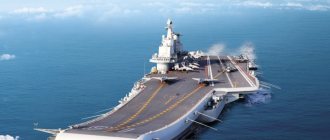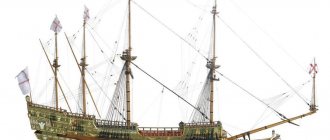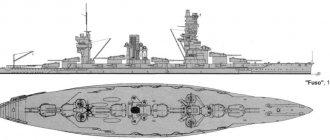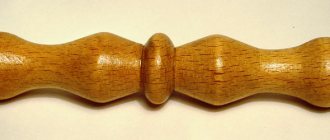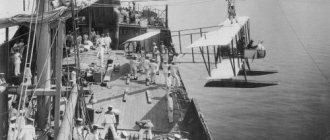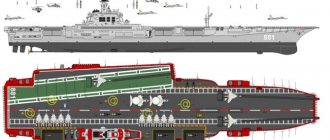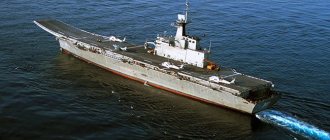In the 30s of the 20th century, in the atmosphere of an increasingly looming World War, many maritime powers began to show a tendency to build super-powerful warships. Real monsters clad in armor - battleships rolled off the stocks of Germany (Bismarck, Tirpitz, Scharnhorst), the USA (4 Iowa-class battleships), England (5 giants of the King George class) and other countries. I tried to join the race and the USSR. Here they only managed to develop the design of the battleship “Soviet Union” at an accelerated pace, but the war was ahead of the shipbuilders. Meanwhile, Japan has taken the lead in this global race. It was she who was “ahead of the rest” in the construction of sea giants. Moreover, if the battleships of the countries mentioned above had a displacement of 40-60 thousand tons, and the caliber of their main guns usually did not exceed 400 mm, then in 1936 the Japanese laid down a series of 4 battleships with a displacement of 72,800 tons, the artillery of which had a fantastic caliber of 460 mm.
How did big ships become fashionable?
Two brothers - "Musashi" and "Yamoto"
Battleships continued to be built, but, in fact, this was already their “swan song.” These floating fortresses were replaced by other, even larger giants - aircraft carriers. The entire course of World War II, especially the grandiose naval battles in the Pacific, showed that the future belonged to these ships. However, until the mid-40s of the last century, both types of these giant ships were used and built. And again, Japan was in the lead in terms of gigantism. The construction of the first two battleships, Yamato and Musashi, was carried out in strict secrecy. The stocks on which they were laid were covered with camouflage nets, fenced with additional high fences, and the windows of the surrounding buildings were walled up. The engineers and workers signed a non-disclosure agreement. In August 1940, the first-born, Yamato, was launched. Since December 1941, it has been in service. But he had no military achievements to his name. As a flagship ship bearing the pennant of the squadron commander, Admiral Yamamoto, the battleship was only present at the battle of Midway, but, having learned about the defeat of its carrier forces in the vanguard, it retreated without firing a single salvo from its unique guns. Later, having received a torpedo from an American submarine, the Yamato was repaired and holed up at bases. Only in April 1945 did the battleship set sail on what would turn out to be its last voyage. The purpose of the operation was to strike at the American troops landing on Okinawa. But the battleship itself became the target of a fierce attack by American torpedo bombers. One plane was shot down, but 3 torpedoes found the side of the Yamato. Soon two more were added to them. The steering gear, as well as electrical equipment, were damaged, as a result of which some of the battleship's anti-aircraft guns could not be used. After this, the last American attack began, during which the ship received at least four more torpedoes. The engine room turned out to be flooded, the ship lost speed and began to fall onto the left side. When the roll reached 80 degrees, a monstrous explosion thundered, the reflection of which was seen even from American ships located dozens of miles from the scene of events. The column of smoke rose to a height of two kilometers. It was the powder magazines of the main caliber towers that exploded - no less than 500 tons of explosives. The human losses of the Japanese were extremely high: 2,498 sailors, including the flagship and commander of the ship, died on the Yamato, and more than 3,000 more on the cruiser and four destroyers accompanying the leader that were destroyed in the same battle. American losses were incomparably smaller - only 10 aircraft.
"Musashi" - the last battleship of the empire
The fate of "Musashi" turned out to be in many ways similar to the fate of his older brother. Before he could go to sea on March 29, 1943, he was attacked by a submarine and received a torpedo in the bow. True, after repairs in June of the same year, the Musashi fought a little off the coast of the Philippines, but did not achieve much success. By the fall of 1944, Japan's affairs on all fronts were rapidly deteriorating. And then it was decided to give the “last and decisive battle” at sea. In accordance with the developed Se-Go ("Victory") plan, the group assembled into one powerful fist included 5 battleships, including the Musashi, plus 12 cruisers and 15 destroyers. This entire armada was supposed to prevent the Americans from landing in the Philippines. On October 22, the squadron went to sea. The very next day, she was attacked by submarines, as a result of which 2 cruisers were killed, and on October 24, massive attacks by American carrier-based aircraft - torpedo bombers and dive bombers - began. Naturally, the most attractive target for them was Musashi. During the first 3 hours of the battle, he was hit by three torpedoes and several bombs. Having taken in many tons of water through the holes, the ship buried its nose and lost speed. The battle for the battleship's survivability lasted 15 hours, after which the American attacks resumed with a vengeance. In total, Musashi was hit by 11 to 19 torpedoes and about 15 bombs. Realizing the hopelessness of the battleship's position, the squadron commander ordered it to throw itself onto the nearest shore. But it was too late - the Musashi capsized and sank, taking more than 1,000 sailors into the abyss, including its commander, Rear Admiral Inoguchi. The Americans lost 18 aircraft in this battle.
The enemy, of course, was surprised, but it was too late
Neither the speed of the ships, nor the caliber of the guns, nor tricks with replacing the turrets of cruisers - nothing could save the Imperial Navy. The reason for the inglorious defeat should be sought in the fact that, in terms of GDP, the Empire of Japan was five times
inferior to the USA. If we look at the situation from the perspective of our time, the ratio of the GDP of Russia and Japan is described by a completely different proportion. Now Japanese claims are again directed in our direction. And, as historical experience shows, this is a very difficult opponent. Assessments of confrontation at sea usually come down to the mention of Tsushima. But, gentlemen, this is the case here. To repeat Tsushima, a fleet of at least equal size is required. A naval battle cannot take place if one of the opponents does not have ships. After all, in terms of the number of combat-ready naval personnel, the Pacific Fleet is 25–30 times inferior to the Japanese Navy.
The only threat may be a situation when the balance of forces takes on an absolute advantage. And then attempts will follow to resolve territorial disputes by force. To which there will be no one and absolutely nothing to object to. Start a nuclear conflict over such trifles? It's easier to open a criminal case. Or they will say that they have long wanted to donate the islands. This is a possible public response at the conference “Russia and Japan: 120 Years of Mutual Friendship,” held somewhere in Seattle. But enough bad jokes. Let's look at the facts.
From battleship to aircraft carriers
At the final stage of the war, the aircraft carrier forces of the Japanese Imperial Navy were practically exhausted (only in the battle of Midway Atoll it lost 4 aircraft carriers). At the same time, no one doubted that it was carrier-based aviation that was becoming the dominant force in the war on the ocean. This realization led to a radical change in the fate of the third ship in the Yamoto-class series. From a planned battleship, she, now named Shinano, was rebuilt into a huge aircraft carrier. Considering the most radical changes to the entire structure of the huge ship, construction was greatly delayed. Nevertheless, on October 5, 1944, the new aircraft carrier was prepared for launching. But "Shinano" was a failure from the moment he was born. In preparation for its launching, the gates of the dry dock in which it was being built were suddenly torn off, and a wave rushing into the dock hit the ship against the walls of the dock. The descent had to be postponed for three weeks. But, one way or another, Shinano became the world's largest aircraft carrier. This record remained with him until 1960, when the first American nuclear-powered aircraft carrier Interprice went to sea. But the Japanese giant was not destined to live to see him.
We would consider it an honor to have such an opponent.
Our eastern neighbors don't brag about what they don't have. But they don't talk about what they have. All that is known for certain about the Japanese Navy is that they hide ships and underestimate the characteristics of weapons. An example would be the awkward classification of ship personnel, in which 250-meter aircraft-carrying ships are passed off as “destroyers.” After the “destroyers” were launched into the water, the expected news followed about the conclusion of a contract for the purchase of vertical take-off fighters. At the same time, the news came from a manufacturer from the USA. The Japanese defense department remained silent until the very end. However, there is nothing to be surprised here. What associations do you have with the phrase “experimental” or “support vessel”? A kilektor, a sea tug, or a long-term construction ship that failed tests, which was ordered to be accepted into “experimental combat operation”?
The top illustration shows the experimental vessel “Viktor Cherokov” (project 20360 OS), an unfinished floating crane-loader of ammunition, converted into a test bench for torpedo weapons. At the bottom is the missile destroyer JS Asuka (test vessel ASE-6102), which is not included in any of the lists. AFAR radars and below-deck missile launchers are “being tested” on board. Along with the most modern naval weapons, gas turbine propulsion, sonar and an anti-submarine helicopter continue to be tested. We are accustomed to the fact that significant events of the defense industry receive publicity from high stands. We are popularly choosing names for top-secret weapons! Discuss the speed and range of missiles. And how many Calibers will be on the new corvettes? Significant achievements of the Japanese military remain outside the public sphere.
Such a short life of "Shinano"
At 18:00 on November 28, 1944, the Shinano, under the command of Captain 1st Rank Abe, accompanied by an escort of 3 destroyers, went to sea for the first time. The command decided to transfer it to the Inland Sea to the Kure base, where the ship was supposed to receive its aircraft. At this time, the lone American submarine Archerfish was patrolling near the Japanese coast, whose task was to pick up the crews of its bombers shot down over the sea from the water. At approximately 21:00, the radar of the surfaced boat detected a large target no more than 12 miles away. The boat commander, Joseph Inright, ordered a rapprochement. Soon the submarine realized who they had unexpectedly met. Meanwhile, Shinano was moving in an anti-submarine zigzag at a speed of 20 knots, surrounded by destroyers. At about 11 p.m., his signalmen discovered the submarine, but Abe did not allow the destroyers to pursue it, so as not to be left without cover. Soon, due to problems in the car, the speed of the Shinano decreased somewhat, and this added to the chances of the boat chasing it. At 3 a.m. on November 29, Archerfish fired a salvo from its bow torpedo tubes, firing 6 torpedoes at once, 4 of which reached the target. The struggle for rescue continued until the morning, but the team, hastily recruited from other ships before the voyage, was unable to cope with the influx of water. The ship, with a list of 20 degrees, sank deeper and deeper into the water. Attempts by destroyers to take it in tow were unsuccessful. At 11 o'clock "Shinano" sank 65 miles from the nearest shore. The destroyers managed to remove 1,080 people from the dying giant. The remaining 1,435 were reported missing. Captain Abe and the watch officer Yasuda with him chose to die along with the ship. The entire first, and also the last, voyage of the super-tsavian carrier lasted only 17 hours. And “Archerfish” managed to break away from the destroyers pursuing it and returned safely to base. Its commander, Joseph Inright, was awarded the US Navy Cross for this victory (by the way, his first in the entire war). Later, after retiring, he wrote a book that immediately became a bestseller, which he simply titled “Shinano.”
Magazine: Forbidden History No. 1, January 2022 Category: History of the Navy Author: Konstantin Riches
Tags: war, World War II, ship, death, Japan, submarine, fleet, aircraft carrier, torpedo, battleship, Forbidden History
- Back
- Forward
Armament of the Unryu aircraft carriers
Anti-aircraft armament included a standard set of 12x127mm/40 Type 89 universal guns in twin mounts (5 A1 model mounts and one A2 model), supplemented by a 51x25mm Type 96 anti-aircraft gun.
In October 1944, on the Unryu and Amagi, the number of 25-mm machine guns was increased to 89, and 6x28-barrel unguided rocket launchers were installed. The fire control of the 127 mm guns was carried out using three stabilized aiming posts type 94 mod. 2 with 4.5-meter rangefinders type 89 and anti-aircraft fire control device type 94 mod. 1, up to 10 type 95 sighting sights were used to control the fire of the machine guns. The armament was supplemented by two type 21 radars for searching for air and surface targets and one type 13 for searching for air targets.
• Navy Directory • Japanese Navy • Warships of the same period •
History of the Unryu aircraft carrier service.
